Njengamartin399
On this page, you find all documents, package deals, and flashcards offered by seller njengamartin399.
- 141
- 0
- 7
Community
- Followers
- Following
148 items
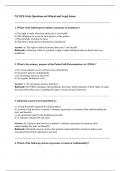
Ethical and Legal Issues
1. Which of the following best defines autonomy in healthcare? a) The right to make decisions about one’s own health b) The obligation to act in the best interest of the patient c) The principle of doing no harm d) The duty to keep patient information confidential Answer: a) The right to make decisions about one’s own health Rationale: Autonomy refers to a patient’s right to make informed choices about their own healthcare. ________________________________________ 2. What is the pr...
- Exam (elaborations)
- • 18 pages •
1. Which of the following best defines autonomy in healthcare? a) The right to make decisions about one’s own health b) The obligation to act in the best interest of the patient c) The principle of doing no harm d) The duty to keep patient information confidential Answer: a) The right to make decisions about one’s own health Rationale: Autonomy refers to a patient’s right to make informed choices about their own healthcare. ________________________________________ 2. What is the pr...
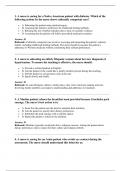
Cultural Diversity`
1. A nurse is caring for a Native American patient with diabetes. Which of the following actions by the nurse shows culturally competent care? • A. Educating the patient using medical jargon. • B. Assessing the patient’s preference for traditional healing methods. • C. Refusing the use of herbal remedies due to lack of scientific evidence. • D. Assuming that the patient will follow prescribed medication routines. Answer: B Rationale: Culturally competent care involves assessing a...
- Exam (elaborations)
- • 20 pages •
1. A nurse is caring for a Native American patient with diabetes. Which of the following actions by the nurse shows culturally competent care? • A. Educating the patient using medical jargon. • B. Assessing the patient’s preference for traditional healing methods. • C. Refusing the use of herbal remedies due to lack of scientific evidence. • D. Assuming that the patient will follow prescribed medication routines. Answer: B Rationale: Culturally competent care involves assessing a...
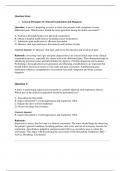
Clinical medicine
all question and answers as per the clinical handbook
- Package deal
- • 8 items •
- General principles of clinical examination and diagnosis: • Exam (elaborations)
- Respiratory medicine • Exam (elaborations)
- Endocrinology • Exam (elaborations)
- Neurology • Exam (elaborations)
- Global health • Exam (elaborations)
- And more ….
all question and answers as per the clinical handbook
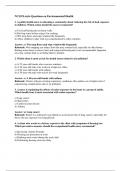
Environmental health
1. A public health nurse is educating a community about reducing the risk of lead exposure in children. Which action should the nurse recommend? a) Use lead-based paint on home walls b) Boil tap water before using it for cooking c) Wet mop floors and wipe windowsills frequently d) Allow children to play with toys manufactured in other countries Answer: c) Wet mop floors and wipe windowsills frequently Rationale: Wet mopping can reduce dust that may contain lead, especially in older homes. ...
- Package deal
- Exam (elaborations)
- • 17 pages •
1. A public health nurse is educating a community about reducing the risk of lead exposure in children. Which action should the nurse recommend? a) Use lead-based paint on home walls b) Boil tap water before using it for cooking c) Wet mop floors and wipe windowsills frequently d) Allow children to play with toys manufactured in other countries Answer: c) Wet mop floors and wipe windowsills frequently Rationale: Wet mopping can reduce dust that may contain lead, especially in older homes. ...
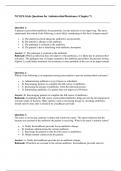
Antimicrobial resistance:
Question 1: A patient is prescribed antibiotics for pneumonia, but the infection is not improving. The nurse understands that which of the following is most likely contributing to this lack of improvement? • A. The patient has been taking the antibiotics inconsistently. • B. The patient is allergic to the antibiotic. • C. The pathogen is resistant to the antibiotic. • D. The patient’s diet is interfering with antibiotic absorption. Answer: C. The pathogen is resistant to the anti...
- Package deal
- Exam (elaborations)
- • 20 pages •
Question 1: A patient is prescribed antibiotics for pneumonia, but the infection is not improving. The nurse understands that which of the following is most likely contributing to this lack of improvement? • A. The patient has been taking the antibiotics inconsistently. • B. The patient is allergic to the antibiotic. • C. The pathogen is resistant to the antibiotic. • D. The patient’s diet is interfering with antibiotic absorption. Answer: C. The pathogen is resistant to the anti...
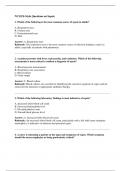
sepsis
NCLEX-Style Questions on Sepsis 1. Which of the following is the most common source of sepsis in adults? A. Respiratory tract B. Urinary tract C. Gastrointestinal tract D. Skin Answer: A. Respiratory tract Rationale: The respiratory tract is the most common source of infection leading to sepsis in adults, especially in patients with pneumonia. 2. A patient presents with fever, tachycardia, and confusion. Which of the following assessments is most critical to confirm a diagnosis of se...
- Package deal
- Exam (elaborations)
- • 19 pages •
NCLEX-Style Questions on Sepsis 1. Which of the following is the most common source of sepsis in adults? A. Respiratory tract B. Urinary tract C. Gastrointestinal tract D. Skin Answer: A. Respiratory tract Rationale: The respiratory tract is the most common source of infection leading to sepsis in adults, especially in patients with pneumonia. 2. A patient presents with fever, tachycardia, and confusion. Which of the following assessments is most critical to confirm a diagnosis of se...
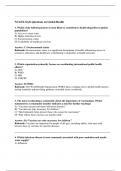
Global health
1. Which of the following factors is most likely to contribute to health disparities in global populations? A) Access to clean water B) Higher education levels C) Socioeconomic status D) Availability of healthcare services Answer: C) Socioeconomic status Rationale: Socioeconomic status is a significant determinant of health, influencing access to resources, education, and healthcare, contributing to disparities in health outcomes. ________________________________________ 2. Which organiz...
- Package deal
- Exam (elaborations)
- • 17 pages •
1. Which of the following factors is most likely to contribute to health disparities in global populations? A) Access to clean water B) Higher education levels C) Socioeconomic status D) Availability of healthcare services Answer: C) Socioeconomic status Rationale: Socioeconomic status is a significant determinant of health, influencing access to resources, education, and healthcare, contributing to disparities in health outcomes. ________________________________________ 2. Which organiz...
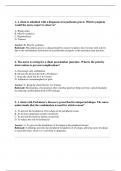
Neurology
________________________________________ 1. A client is admitted with a diagnosis of myasthenia gravis. Which symptom would the nurse expect to observe? A. Bradycardia B. Muscle weakness C. Hyperreflexia D. Tremors Answer: B. Muscle weakness Rationale: Myasthenia gravis is characterized by muscle weakness that worsens with activity due to the autoimmune destruction of acetylcholine receptors at the neuromuscular junction. ________________________________________ 2. The nurse is caring f...
- Package deal
- Exam (elaborations)
- • 19 pages •
________________________________________ 1. A client is admitted with a diagnosis of myasthenia gravis. Which symptom would the nurse expect to observe? A. Bradycardia B. Muscle weakness C. Hyperreflexia D. Tremors Answer: B. Muscle weakness Rationale: Myasthenia gravis is characterized by muscle weakness that worsens with activity due to the autoimmune destruction of acetylcholine receptors at the neuromuscular junction. ________________________________________ 2. The nurse is caring f...
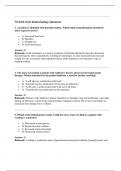
Endocrinology
1. A patient is admitted with hypothyroidism. Which clinical manifestation should the nurse expect to assess? • A. Increased heart rate • B. Diarrhea • C. Weight loss • D. Cold intolerance Answer: D Rationale: Cold intolerance is a typical symptom of hypothyroidism because the decreased thyroid function slows metabolism, resulting in intolerance to cold. Increased heart rate and weight loss are associated with hyperthyroidism, while diarrhea is not typically a sign of hypothyroidis...
- Package deal
- Exam (elaborations)
- • 21 pages •
1. A patient is admitted with hypothyroidism. Which clinical manifestation should the nurse expect to assess? • A. Increased heart rate • B. Diarrhea • C. Weight loss • D. Cold intolerance Answer: D Rationale: Cold intolerance is a typical symptom of hypothyroidism because the decreased thyroid function slows metabolism, resulting in intolerance to cold. Increased heart rate and weight loss are associated with hyperthyroidism, while diarrhea is not typically a sign of hypothyroidis...

Respiratory medicine
Question 1: A nurse is caring for a client with chronic obstructive pulmonary disease (COPD) who is experiencing dyspnea. Which of the following interventions should the nurse implement first? A. Increase the client's oxygen to 6 L/min via nasal cannula B. Encourage the client to drink fluids to thin secretions C. Assist the client into the tripod position D. Administer a prescribed bronchodilator Answer: C. Assist the client into the tripod position Rationale: The tripod position allo...
- Package deal
- Exam (elaborations)
- • 22 pages •
Question 1: A nurse is caring for a client with chronic obstructive pulmonary disease (COPD) who is experiencing dyspnea. Which of the following interventions should the nurse implement first? A. Increase the client's oxygen to 6 L/min via nasal cannula B. Encourage the client to drink fluids to thin secretions C. Assist the client into the tripod position D. Administer a prescribed bronchodilator Answer: C. Assist the client into the tripod position Rationale: The tripod position allo...
